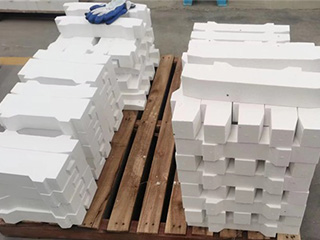Corundum brick is a high-performance refractory material that is commonly used in industrial furnaces and kilns where high temperatures, harsh chemical environments, and mechanical stresses are present. It is made of corundum, a naturally occurring mineral that is one of the hardest materials on Earth, with a Mohs hardness rating of 9. Corundum brick is known for its excellent high-temperature resistance, good chemical stability, and high mechanical strength. In this article, we will discuss the science behind corundum brick, including its properties and performance.

Properties of Corundum Brick
Corundum brick is a type of refractory brick that is made of corundum as the main raw material, along with some additives and binders. The properties of corundum brick are largely determined by the properties of corundum itself. Here are some of the key properties of corundum brick:
1.High melting point: Corundum has a very high melting point of around 2050°C, which means that corundum brick can withstand extremely high temperatures without melting or deforming.
2.Good thermal shock resistance: Corundum brick has a low thermal expansion coefficient, which means that it can withstand rapid changes in temperature without cracking or breaking.
3.Excellent chemical stability: Corundum is a chemically inert material that is resistant to most acids, alkalis, and other chemical agents. Corundum brick can therefore be used in environments where aggressive chemicals are present.
4.High mechanical strength: Corundum is a very hard material that is also resistant to abrasion, erosion, and impact. Corundum brick therefore has high mechanical strength and can withstand mechanical stresses such as vibration and mechanical shock.
5.Low porosity: Corundum brick has a low porosity, which means that it is resistant to penetration by liquids and gases. This property is particularly important in high-temperature environments where materials can easily become brittle and porous.
Performance of Corundum Brick
The performance of corundum brick depends on several factors, including the quality of the raw materials used, the manufacturing process, and the conditions in which the brick is used. Here are some of the key performance factors for corundum brick:
1.Thermal conductivity: Corundum brick has a low thermal conductivity, which means that it can insulate against heat transfer. This property is important in industrial furnaces and kilns, where it is necessary to maintain a consistent temperature throughout the process.
2.Thermal shock resistance: Corundum brick has good thermal shock resistance, which means that it can withstand rapid changes in temperature without cracking or breaking. This property is particularly important in high-temperature environments where thermal cycling is common.
3.Corrosion resistance: Corundum brick is resistant to most acids, alkalis, and other chemical agents, which makes it ideal for use in chemical processing applications.
4.Mechanical strength: Corundum brick has high mechanical strength, which means that it can withstand mechanical stresses such as vibration and mechanical shock. This property is particularly important in industrial applications where heavy machinery is present.
5.Durability: Corundum brick is a very durable material that can last for many years without requiring replacement. This property is particularly important in industrial applications where downtime can be costly.
Manufacturing Process
Corundum brick is typically manufactured using a combination of sintering and hot-pressing techniques. The raw materials used in the manufacturing process include high-purity corundum powder, bonding agents, and fillers. The manufacturing process typically involves the following steps:
1.Raw material preparation: The raw materials are weighed and mixed together in the correct proportions. The mixture is then ground into a fine powder.
2.Molding: The powder is then pressed intothe desired shape and size using a hydraulic press or other molding technique.
3.Drying: The molded bricks are dried in a furnace or other drying equipment to remove any moisture.
4.Firing: The dried bricks are fired in a kiln at high temperatures, typically between 1600°C and 1800°C, to sinter the raw materials together and create a strong bond between the corundum particles.
5.Hot pressing: In some cases, the fired bricks may undergo a hot-pressing process to further increase their density and strength. Hot pressing involves applying high pressure and temperature to the bricks while they are still hot from the firing process.
6.Quality control: The finished bricks are inspected for defects and tested for their physical and chemical properties before being shipped to customers.
Applications of Corundum Brick
Corundum brick is used in a wide range of industrial applications where high temperatures, harsh chemical environments, and mechanical stresses are present. Some common applications of corundum brick include:
1.Steelmaking: Corundum brick is used to line the furnaces and ladles used in the production of steel, where high temperatures and aggressive chemicals are present.
2.Glassmaking: Corundum brick is used in the production of glass to line the furnaces and kilns used to melt and shape the glass.
3.Petrochemical processing: Corundum brick is used in the production of petrochemicals to line the reactors and other equipment used in the chemical reactions.
4.Ceramic manufacturing: Corundum brick is used in the manufacturing of ceramics to line the kilns and furnaces used to fire the ceramic materials.
5.Power generation: Corundum brick is used in power plants to line the boilers and other high-temperature equipment used to generate electricity.
Conclusion
Corundum brick is a high-performance refractory material that is known for its excellent high-temperature resistance, good chemical stability, and high mechanical strength. It is made of corundum, a naturally occurring mineral that is one of the hardest materials on Earth. Corundum brick is used in a wide range of industrial applications where high temperatures, harsh chemical environments, and mechanical stresses are present. The manufacturing process for corundum brick involves a combination of sintering and hot-pressing techniques, and the finished bricks undergo rigorous quality control testing before being shipped to customers.
Contact: Mgr. Han
Phone: 0086-13589497465
Email: 1255953279@qq.com
Add: Industrial Area of Lingzi Town,Zichuan District,Zibo City, Shandong,China